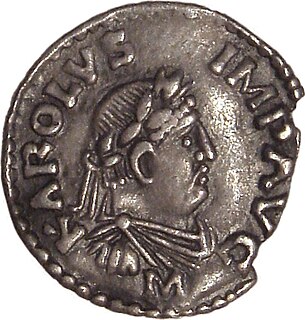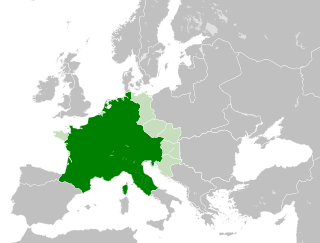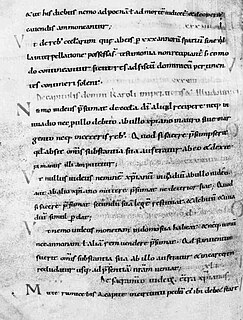Related Research Articles

Charlemagne or Charles the Great, a member of the Carolingian dynasty, was King of the Franks from 768, King of the Lombards from 774, and the first Emperor of the Romans from 800. Charlemagne succeeded in uniting the majority of western and central Europe and was the first recognized emperor to rule from western Europe after the fall of the Western Roman Empire around three centuries earlier. The expanded Frankish state that Charlemagne founded was the Carolingian Empire. He was canonized by Antipope Paschal III—an act later treated as invalid—and he is now regarded by some as beatified in the Catholic Church.

Feudalism, also known as the feudal system, was the combination of the legal, economic, military, and cultural customs that flourished in medieval Europe between the 9th and 15th centuries. Broadly defined, it was a way of structuring society around relationships that were derived from the holding of land in exchange for service or labour. Although it is derived from the Latin word feodum or feudum (fief), which was used during the Medieval period, the term feudalism and the system which it describes were not conceived of as a formal political system by the people who lived during the Middle Ages. The classic definition, by François Louis Ganshof (1944), describes a set of reciprocal legal and military obligations which existed among the warrior nobility and revolved around the three key concepts of lords, vassals, and fiefs.

In the history of Europe, the Middle Ages or medieval period lasted approximately from the 5th to the late 15th centuries, similar to the post-classical period of global history. It began with the fall of the Western Roman Empire and transitioned into the Renaissance and the Age of Discovery. The Middle Ages is the middle period of the three traditional divisions of Western history: classical antiquity, the medieval period, and the modern period. The medieval period is itself subdivided into the Early, High, and Late Middle Ages.

The Carolingian Empire (800–888) was a large Frankish-dominated empire in western and central Europe during the Early Middle Ages. It was ruled by the Carolingian dynasty, which had ruled as kings of the Franks since 751 and as kings of the Lombards in Italy from 774. In 800, the Frankish king Charlemagne was crowned emperor in Rome by Pope Leo III in an effort to transfer the Roman Empire from east to west. The Carolingian Empire is considered the first phase in the history of both the Holy Roman Empire, which lasted until 1806, and France.

Childeric III was King of Francia from 743 until he was deposed by Pope Zachary in March 751 at the instigation of Pepin the Short. Although his parentage is uncertain, he is considered the last Frankish king from the Merovingian dynasty. Once Childeric was deposed, Pepin the Short, who was the father of emperor Charlemagne, was crowned king, initiating the Carolingian dynasty.

The Carolingian Renaissance was the first of three medieval renaissances, a period of cultural activity in the Carolingian Empire. It occurred from the late 8th century to the 9th century, taking inspiration from the Christian Roman Empire of the fourth century. During this period, there was an increase of literature, writing, the arts, architecture, jurisprudence, liturgical reforms, and scriptural studies.
A missus dominicus, Latin for "envoy[s] of the lord [ruler]" or palace inspector, also known in Dutch as Zendgraaf, meaning "sent Graf", was an official commissioned by the Frankish king or Holy Roman Emperor to supervise the administration, mainly of justice, in parts of his dominions too remote for frequent personal visits. As such, the missus performed important intermediary functions between royal and local administrations. There are superficial points of comparison with the original Roman corrector, except that the missus was sent out on a regular basis. Four points made the missi effective as instruments of the centralized monarchy: the personal character of the missus, yearly change, isolation from local interests and the free choice of the king.

Francia, also called the Kingdom of the Franks, Frankish Kingdom, Frankland or Frankish Empire, was the largest post-Roman barbarian kingdom in Western Europe. It was ruled by the Franks during Late Antiquity and the Early Middle Ages. After the Treaty of Verdun in 843, West Francia became the predecessor of France, and East Francia became that of Germany. Francia was among the last surviving Germanic kingdoms from the Migration Period era before its partition in 843.
A capitulary was a series of legislative or administrative acts emanating from the Frankish court of the Merovingian and Carolingian dynasties, especially that of Charlemagne, the first emperor of the Romans in the west since the collapse of the Western Roman Empire in the late 5th century. They were so called because they were formally divided into sections called capitula.

A pagus was a Roman administrative term designating a rural subdivision of a tribal territory, which included individual farms, villages (vici), and strongholds (oppida) serving as refuges, as well as an early medieval geographical term. From the reign of Diocletian onwards, the pagus referred to the smallest administrative unit of a province. These geographical units were used to describe territories in the Merovingian and Carolingian periods, without any political or administrative meaning.

The Battle of Tertry was an important engagement in Merovingian Gaul between the forces of Austrasia under Pepin II on one side and those of Neustria and Burgundy on the other. It took place in 687 at Tertry, Somme, and the battle is presented as an heroic account in the Annales mettenses priores. After achieving victory on the battlefield at Tertry, the Austrasians dictated the political future of the Neustrians.

Theodulf of Orléans was a writer, poet and the Bishop of Orléans during the reign of Charlemagne and Louis the Pious. He was a key member of the Carolingian Renaissance and an important figure during the many reforms of the church under Charlemagne, as well as almost certainly the author of the Libri Carolini, "much the fullest statement of the Western attitude to representational art that has been left to us by the Middle Ages". He is mainly remembered for this and the survival of the private oratory or chapel made for his villa at Germigny-des-Prés, with a mosaic probably from about 806. In Bible manuscripts produced under his influence, the Book of Baruch and the Letter of Jeremiah became part of the Western (Vulgate) Bible canon.
Thegan of Trier was a Frankish Roman Catholic prelate and the author of Gesta Hludowici imperatoris which is a principal source for the life of the Holy Roman Emperor Louis the Pious, the son and successor of Charlemagne.

The Council of Frankfurt, traditionally also the Council of Frankfort, in 794 was called by Charlemagne, as a meeting of the important churchmen of the Frankish realm. Bishops and priests from Francia, Aquitaine, Italy, and Provence gathered in Franconofurd. The synod, held in June 794, allowed the discussion and resolution of many central religious and political questions.
Carolingian schools comprised a small number of educational institutions which had a major share in the Carolingian renaissance, specifically cathedral schools and monastic schools.

Christopher John Wickham, is a British historian and academic. From 2005 to 2016, he was Chichele Professor of Medieval History at the University of Oxford and Fellow of All Souls College, Oxford: he is now emeritus professor. He had previously taught at the University of Birmingham from 1977, rising to be Professor of Early Medieval History from 1997 to 2005.

The Capitulary for the Jews is a set of six short legal prescriptions concerning Jews in the Carolingian Empire. They were gathered together and published under the title by which they are now known by Alfred Boretius in 1883, but only the first three and possibly the fourth are derived from a single source; the fifth and sixth are from an unrelated source. In one manuscript, the sixth "chapter" (capitulum) is said to have been taken "from Emperor Charles' statutes", indicating either Charlemagne or Charles the Bald. Its content, however, is inconsistent with the known Jewish policies of these emperors.
The Admonitio generalis is a collection of legislation known as a capitulary issued by Charlemagne in 789, which covers educational and ecclesiastical reform within the Frankish kingdom. Capitularies were used in the Frankish kingdom during the Carolingian dynasty by government and administration bodies and covered a variety of topics, sorted into chapters. Admonitio generalis is actually just one of many Charlemagne's capitularies that outlined his desire for a well-governed, disciplined Christian Frankish kingdom. The reforms issued in these capitularies by Charlemagne during the late 8th century reflect the cultural revival known as the Carolingian Renaissance.
The Capitulare de villis is a text composed sometime in the late 8th or early 9th century that guided the governance of the royal estates during the later years of the reign of Charlemagne. It lists, in no particular order, a series of rules and regulations on how to manage the lands, animals, justice, and overall administration of the king's property and assets. The document was meant to lay out the instructions and criteria for managing Charlemagne's estates and was thus, an important part of his reform of Carolingian government and administration.
The Valle Trita was a remote area lying beneath the highest peak in the Central Apennines. It was mainly forest and pastureland, classified as a gualdus during the Lombard period. It is famous for the long dispute between its inhabitants and the monastery of San Vincenzo al Volturno in the early Middle Ages.
References
- ↑ For instance, Stone, Rachel (2011). "Morality and Masculinity in the Carolingian Empire". Cambridge Core. doi:10.1017/cbo9781139017473. p. 226
- ↑ Wickham, Chris, 1950- (2006). Framing the early Middle Ages : Europe and the Mediterranean, 400-800. Oxford: Oxford University Press. ISBN 0-19-921296-1. OCLC 70764463.
{{cite book}}: CS1 maint: multiple names: authors list (link), p. 290 - ↑ West, Charles (2018-01-01), "Carolingian Kingship and the Peasants of Le Mans : the Capitulum in Cenomannico pago datum", Charlemagne : les temps, les espaces, les hommes, Haut Moyen ?ge, Brepols Publishers, vol. 34, pp. 227–244, doi:10.1484/m.hama-eb.5.114713, ISBN 978-2-503-57797-5 , retrieved 2019-11-23 Open Access version https://hcommons.org/deposits/item/hc:24809/